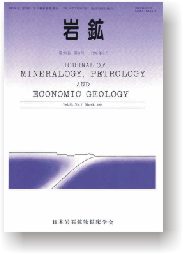All issues

Volume 90, Issue 3
March
Displaying 1-3 of 3 articles from this issue
- |<
- <
- 1
- >
- >|
ORIGINAL ARTICLES
-
Katsushi SHIRAHATA, Takao HIRAJIMA1995Volume 90Issue 3 Pages 69-79
Published: 1995
Released on J-STAGE: January 17, 2007
JOURNAL FREE ACCESSGarnet in the Sanbagawa belt commonly shows concentric compositional zoning of a normal type. However, chemically sector zoned garnet has also been reported. The additional discovery of new localities in the Besshi district of the Sanbagawa belt shows this is a more widespread phenomenon than has generally been realized. All the new localities are situated in the oligoclase-biotite zone on the north side of the Tonaru amphibolite mass. The sector-zoned garnet is generally fine-grained (ca. 0.1 mm in diameter) and occurs in pinkish quartz-rich bands with or without rare medium-grained (ca. 0.4 mm) garnet. The comparative study of compositional zoning of these garnets indicates that the sector-zoned garnet has grown in the latest stage of the Sanbagawa metamorphism. The spatial association of sector-zoned garnet with amphibolite masses (in particular the Tonaru mass) suggests the development of the sector zoning may be genetically linked to the emplacement of these bodies.View full abstractDownload PDF (4858K) -
Yasutaka YOSHIMURA, Masaaki OBATA1995Volume 90Issue 3 Pages 80-92
Published: 1995
Released on J-STAGE: January 17, 2007
JOURNAL FREE ACCESSGarnets with textural sector structures were found in garnet-biotite-cordierite gneisses from the Higo metamorphic belt, western-central Kyushu. The garnet contains dusty core and clear margin. The dusty core is hexagonal or octagonal in shape in thin section, and contains abundant very fine inclusions (<1 μm) of both fluid and solid phases. The fine inclusions are aligned nearly straight, being perpendicular to the outline of the dusty core. The sector structure is interpreted in terms of the rhombododecahedral model garnet that consists of twelve rhombohedral pyramids within which fine inclusions are aligned straight perpendicular to the basal surface {110}. The garnets show well developed compositional zoning (Mn- and Ca-rich core; Mg- and Ferich rim). The compositional contour lines, obtained from two-dimensional compositional mapping using an electron probe microanalyzer, are nearly perpendicular to the fine-inclusion lineations within each sector. We consider that this orthogonal relationship between the inclusion-lineation and the compositional structures is an important primary feature determined during the crystal growth of garnet, and that the isochemical contour lines (or isochemical surfaces in three dimensions) are ‘isochronal surfaces’ parallel to crystal surfaces {110} during the crystal growth. The possibility of the surface equilibrium during the crystal growth and the extent of the diffusion modification of the primary (i.e., growth) zoning are discussed.View full abstractDownload PDF (5677K) -
Tomoaki MORISHITA, Shoji ARAI, Natsuko TAKAHASHI1995Volume 90Issue 3 Pages 93-102
Published: 1995
Released on J-STAGE: January 17, 2007
JOURNAL FREE ACCESSThe symplectite is characteristic of the Horoman peridotite of Hidaka belt, Hokkaido, northern Japan. The symplectite is composed of vermicular chromian spinel, orthopyroxene and clinopyroxene, and is surrounded by a fine-grained aggregate, which is composed of coarser and equant grains of the same minerals as in the symplectite. Textural and chemical characteristics of the symplectite systematically change depending on the degree of refractoriness of the peridotite. With an increase of refractoriness of the peridotite, the symplectite minerals become coarser and more refractory. The Cr# (=Cr/ (Cr+Al) atomic ratio) of a discrete spinel is distinctly higher and increases more rapidly with an increase of the Fo content of olivine than the Cr#'s of spinels in the symplectite and fine-grained aggregate.
The symplectite was formed by a breakdown of garnet+olivine, combined with partial melting and melt extraction. The differences of spinel composition depending both on the texture and on the degree of refractoriness of rock may indicate a process of inhomogeneous melting and melt extraction. The coarse-grained olivine-rich part of peridotites, which has simple grain boundaries and is relatively easy to be wetted by melt, was more effectively melted, while the symplectite and surrounding fine-grained aggregate, which have complicated grain boundaries and are enriched with pyroxenes, were less easily wetted by melt, and were less effectively melted. The relationship between the symplectite and the surrounding fine-grained aggregate may be inherited from the garnet-kelyphite rim relationship. Preservation of a delicate texture of the symplectite may mean that the heating duration was short on melting.View full abstractDownload PDF (5652K)
- |<
- <
- 1
- >
- >|